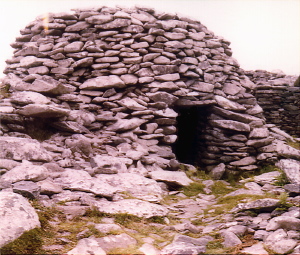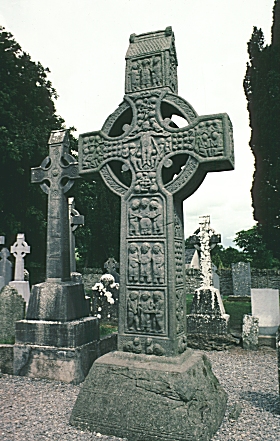Father
Seraphim is once again scheduling pilgrimages to the holy places of the Celtic
lands. If you are interested, this site
has the details:
A
pilgrimage is not about escapism. It is
about an intimate encounter with the wholeness (holiness) of men and women who
have been healed of every fallen, disordered passion, and bringing a small bit
of their wholeness back with us into our everyday lives - something our broken
world desperately needs right now.
Below
are a few more thoughts on the Orthodox Celts from Fr Ambrose that may be of
interest to folks living in our times of confusion, despair, uprootedness,
madness, etc.:
. . . “Although the climate and situation of
Britain were very different from the hot deserts of Egypt, there were
principles-simplicity, prayer, fasting, spiritual warfare, wisdom, and
evangelism-that were easy to translate to the communities of these isles."
(Michael Mitton, The Soul of Celtic Spirituality in the Lives of Its Saints)
But this means that entering into the spiritual, mental, emotional, and
physical world of a Celtic Christian monk is difficult-not impossible, but
difficult.
First we must realize
that the Celts had no concept of privacy or individuality such as we have
today. Families did not live in separate rooms, but all together; no one
thought about the idea of "compartmentalizing space" and only hermits
and anchorites felt a calling to be alone in spiritual solitude with God,
although monks had separate cells, just as monastics did in the Egyptian
Thebaid. The idea that people are separate individuals from the group was not
only unheard-of, but would have been considered dangerous, even heretical.
Self-absorption, "moods," and being temperamental-all of these things
would have been considered abnormal and sinful. It wasn't until the 13th and
14th centuries that people in the West started keeping journals or diaries, and
there were no memoirs-also signs of individuality and privacy, of singling
oneself out from the family, group, or community-nor were there actual
real-life portraits of individuals, until the 14th century. (The art of
realistic portraiture developed in response to the medieval idea of romance-for
an accurate portrait was a substitute for an absent husband or wife.)
Furthermore,
"'the dominant institution of Celtic Christianity was neither the parish
church nor the cathedral, but the monastery, which sometimes began as a
solitary hermit's cell and often grew to become a combination of commune,
retreat house, mission station...school [and, in general] a source not just of
spiritual energy but also of hospitality, learning, and cultural
enlightenment." (Ian Bradley, quoted in Mitten, Ibid.) It was only
much later that people began to be gathered into separate parishes, and even
later before bishops had dioceses that were based on geographical lines rather
than just being the shepherd of a given tribe or group, "being bishops of
a community, rather than ruling areas of land. The idea of 'ruling a diocese'
was quite foreign to the Celtic way of thinking." (Ibid.)
If
you think about what all of this means in terms of how we today view ourselves,
the world in which we live, and the values that we have today, you can see how
difficult it's going to be for us to enter into the world of the Celts. Today
we are quite obsessive about such things as privacy and individuality, of
"being our own selves" and "getting in touch with the inner
man" and other such self-centered nonsense. But the Celtic Christian
understood, just as did and do Eastern Christians, that man is saved in
community; if he goes to hell, he goes alone.
So
the orientation of those Christian Celts to God and the other world was very
different than the orientation of our modern world, no matter how devout or
pious we may be, and this makes the distance between us and the world of Celtic
monasticism far greater than just the span of the centuries. A renowned
scholar, Sir Samuel Dill, writing generally about Christians in the West at
this same period of time, said: "The dim religious life of the early
Middle Ages is severed from the modern mind by so wide a gulf, by such a
revolution of beliefs that the most cultivated sympathy can only hope to revive
in faint imagination ....[for it was] a world of...fervent belief which no
modern man can ever fully enter into....It is intensely interesting, even
fascinating...[but] between us and the early Middle Ages there is a gulf which
the most supple and agile imagination can hardly hope to pass. He who has
pondered most deeply over the popular faith of that time will feel most deeply
how impossible it is to pierce its secret." (Quoted in "Vita
Patrum", Fr. Seraphim Rose)
But
is it really "impossible"? To enter their world-the world of Celtic
Christianity, which is the same as Celtic monasticism--we must find a way to
see things as they did-not as we do today-; to hear, taste, touch, pray, and
think as they did. And this is what I mean by the word
"spirituality"-a whole world-view. We must examine them in the full
context of their actual world-which was a world of Faith, and not just any
Faith, but the Christian Faith of Christians in both the Eastern and Western
halves of Christendom in the first thousand years after Christ. Spirituality is
living, dogmatic, theology. This is the only way we can begin to understand how
Celtic Monasticism can be a model of sanctity for us living today, more than a
millennium after their world ceased to be. Remember, I said it would be
difficult to enter their world; difficult, but not impossible... When we speak
of someone or something being a "model," what do we mean? In this
instance-speaking about Celtic monasticism as a "model"-we mean
something that is a standard of excellence to be imitated. But here I'm not
speaking of copying external things about Celtic monasteries-such as
architecture, style of chant, monastic habit, etc., which are, after all
cultural "accidents." I'm speaking of something inward, of an inner
state of being and awareness. It's only in this sense that Celtic monasticism
can be, for those who wish it, a "model of sanctity."
But
what do I mean by "sanctity"? We must be careful not to slip into
some kind of vague, New Age warm "fuzzies" which are more gnostic
than Christian and have more to do with being a "nice" person than
encountering the Living God in this life. By sanctity I mean what the Church
herself means: holiness—which is nothing more or less than imitation of Christ
in the virtues, and striving to die to oneself through humility, so as to be
more and more alive to Christ, successfully cutting off one's own will in order
to have, only the will of Christ, as St. Paul says in his epistle to the Galatians
(2:20): "I am crucified with Christ: nevertheless I live; yet not I, but
Christ liveth in me... " So, holiness means dying to oneself and
especially to one's passions, more and more, so as draw closer and closer to
the Lord God Himself, through Jesus Christ, and Him crucified and risen. In
addition, Celtic Christians had the concept of "hallowing" or
"hallowed"-an old fashioned term that today has survived only in the
unfortunate pagan holiday called "Halloween" (from "All Hallows
Eve"-which began as the vigil for the Western Feast of All Souls Day and
later took on vile pagan overtones). To early British Christians, something or
someone that was "hallowed" was "set apart" from others and
sanctified for service to God. Thus, a priest's ordination or a monastic's
tonsuring was his "hallowing."
And
so, thus it was that those blessed and hallowed monastics of Celtic lands
modeled forth certain principles that we can still see, study, understand, and
imitate today.
. . .
Source: http://www.oodegr.com/english/brit_celt_orthodoxy/celtic_monasticism.htm,
opened 15, 16 Feb. 2018
Pictures
from same page as Fr Ambrose’s essay, 16 Feb. 2018
--
Holy
Ælfred the Great, King of England, South Patron, pray for us sinners at the Souð, unworthy though we are!
Anathema
to the Union!


No comments:
Post a Comment